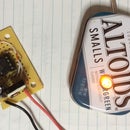Introduction: Centering a Painting on a Wall With Off-Center Studs
An interesting challenge is posed to American families who want to decorate their new home by hanging a very nice but heavy painting on the wall. To our foreign readers: walls in modern American homes consist of a timber frame covered with sheets of so–called “drywall”. The latter is a ½-inch layer of gypsum wrapped in paper. As such, drywall is not strong enough to support heavy objects. Therefore, these objects must be anchored through drywall directly to the supporting vertical beams, made of wood, called “studs”. Studs can be detected with an electronic stud scanner.
For the reasons of visual aesthetics, it is often desirable to place a painting symmetrically; meaning the picture’s central axis should coincide with the central axis of the wall - see the above image.
Framed heavy paintings are sold with a strong hanging wire made of steel, whose ends are attached to the frame’s side beams. (If an upper part of the frame were used for hanging, then in time it would distort by picture's weight.) If a stud happens to be positioned exactly on the wall’s axis of symmetry, then one strong nail would solve our “picture problem”. Similarly, two studs positioned symmetrically on both sides of the central axis make the problem easy to solve. However, these ideal cases are rare since builders are constrained by the building code and most often studs are arranged non-symmetrically, as shown in the image above.
The non-symmetrical positioning of wall studs makes our picture problem difficult. Nevertheless, it is still solvable with just two cleverly positioned nails. If you are interested in the rationale of how it can be done, and maybe learn something, then proceed to Steps 1 and 2. If you are an impatient type and don't mind the "black box" answer, then proceed directly to Step 3.
Step 1: How Is This Possible?
Consider the initial scenario illustrated by the first image. In there, the picture is hanging on a single nail N1. A1 and A2 in denote anchor points of the steel wire symbolized by thick black line. Nail N2 is only touching the wire and provides no support. Now, raise the nail N2 up as shown in the next image. This creates a moment of force that tries to rotate the picture counterclockwise. To compensate, a clockwise moment must be created. This is only possible when the N1 is to the left of picture's center of gravity. Which means the entire picture must shift to the right by {delta}x inches. In other words, shifting N2 up by {delta}y inches (within reasonable range) uniquely determines the corresponding horizontal displacement {delta}x. Therefore, an optimal arrangement of nails N1 and N2 may position the picture exactly in the center of the wall.
The obvious question is how to determine a proper {delta}y for a desired {delta}x? This is what this instructable is all about
Step 2: The Underlying Principles
First, the principles of statics require that at a mechanical equilibrium the sum of all forces acting on our hanging picture must be zero (equation 1). The sum of all force moments must be zero, as well (equation 2). The latter requires the same center of rotation for the purpose of computing moments. However, at equilibrium one can choose any point as the center of rotation! To see that, suppose that one shifts the center of rotation by a vector s to another position. Consequently, all the rotation arm vectors, r_i, must be shifted by s - see equation 3. The equilibrium of moments still holds because the second sum disappears as a result of equation 1. (I must apologize to mechanical engineers at this point: I am sure this trivial result is taught as some named theorem; I just don’t happen to know it as such.)
In particular, the force vectors acting on our picture are quite simple. The gravity acts on the picture’s center of gravity with a down force mg (m=mass, g=Earth’s gravitational acceleration). It is countered by two wire tension forces, T1 and T2, acting on anchors A1 and A2, respectively - see the image above. The equilibrium of forces condition translates to a particularly simple equation 4. Choosing the center of rotation as a point exactly in between the anchors leads us to a simple expression for the equilibrium of moments - see equation 5. The first term there vanishes because R_g and mg are parallel.
You can easily verify that the above conditions are satisfied for a symmetric picture (in which R1 and R2 are equal in magnitude) only when the relations 6) hold where T_ix and T_iy {i=1,2} indicate vertical and horizontal components of tension vectors, respectively.
Step 3: Final Result
The conditions derived in Step 2 lead to very nice geometrical constraints imposed on the hanging wire. In particular, the horizontal and vertical components of tension forces at both anchors must be equal in magnitude, respectively. This means that angles N1-A1-P1 and N2-A2-P2 in the first figure must be congruent! In turn, the two right triangles, A1N1P1 and A2N2P2, are similar. These congruence conditions are sufficient to solve our problem.
Instead of ambiguous “{delta}y” we will find a better defined {delta}h – the difference in vertical position of the nails, as shown in the first image. This is the sought unknown. The knowns are quantities easily measurable with a tape measure:
- W = wire length
- D = distance between anchors
- x = distance between studs
- {delta}x = desired horizontal shift
The unknowns are
- Partial wire lengths d1, d and d2
- Nail heights h1 and h2, as well as their difference {delta}h = h1 - h2,
- Partial lengths x1 and x2
The aforementioned congruence conditions, plus length constraints, provide the system of equations 7) sufficient to find {delta}h. But keep in mind that the {delta}x cannot exceed limit imposed by equation 8! Solution of this system of equations is not difficult, but quite tedious. I will spare you the lengthy algebra by writing the final solution for {delta}h in equation 9, where all the partial quantities are explained in the collection 10.
I have posted and Excel spreadsheets to ease the tedium of coding these formulas in the related GitHub repository. In there, you will have to enter measured knowns, W, D, x as well as desired shift {delta}x. Please note that unlike in Step 1 this {delta}x is the distance between two vertical lines: 1) the line of wall symmetry, 2) the line of stud symmetry (see the first image in this Step).
For example, a painting in authors home, shown in the last image, has the anchor separation D=122.5 cm and wire W=126.5 cm long. Studs nearest the wall center are separated by x=70 cm. The picture had to be shifted horizontally by 4.8 cm for perfect centering. This was achieved by positioning one nail approximately 3.8 cm lower than the other nail.
Credits:
The unicorn image used in this tutorial, titled “Legend”, was created by a talented artist known only by his/her pseudonym “frenchromeo”. I have downloaded it many years ago from the www.deviantart.com website. The artist’s account is no longer there and relevant Google searches provide only dead links…













